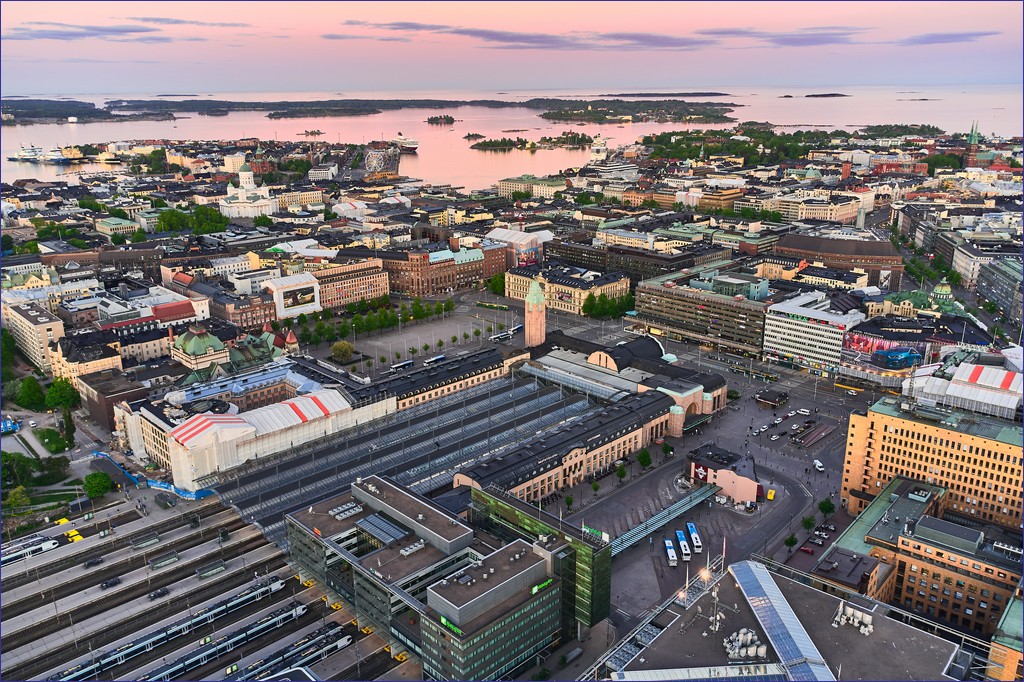Helsinki is the capital of Finland and the country’s largest city. Since the 15th century, a small fishing settlement existed on the site of today’s Helsinki. The city was officially founded in 1550 by King Gustav Vasa. From that period comes the Swedish name Helsingfors. The city was often destroyed by the Russians during the Russo-Swedish wars. After the great fire of 1812 that destroyed Turku, the capital of Finland was moved to Helsinki. At that time Finland was part of Russia. The new capital was redesigned with wide streets and neoclassical buildings modeled after the architecture of St. Petersburg. After World War II, the city developed rapidly. In 1952, Helsinki hosted the Summer Olympic Games.
Helsinki is a popular destination for tourists from all over the world. The Finnish capital is easy to reach by plane or ferry, and trains depart from the railway station to all major Finnish cities. Long-distance buses complement the network, transporting passengers to places not served by rail.
The most important landmarks and attractions of Helsinki
The heart of the city is Senate Square (Senaatintori), surrounded by a grid of wide streets and imposing buildings. On the square stands the Lutheran Cathedral from the mid-19th century (Tuomiokirkko). Granite steps lead up to the cathedral, a popular meeting spot for locals. The cathedral was designed by the renowned German architect Carl Ludwig Engel. Engel died in 1840, and construction continued after his death. The building was completed in 1850. In front of the cathedral stands a monument to the Russian Tsar Alexander II, erected in 1894. The eastern part of the square is occupied by the Government Palace, which, since Finland’s independence, has been known as the Senate House. In 1904, in this palace, an enraged official assassinated the Russian governor and then committed suicide. Other notable buildings on Senate Square include the university library, the main university building, and the House of Nobility.
In the immediate vicinity of Senate Square is the City Museum (Helsingin kaupunginmuseo), which presents the history of Helsinki, including reconstructed residential interiors from the 1960s, clothing, and toys. Along the waterfront stretches the city’s main market square, where visitors can buy souvenirs or taste local dishes, though much of the merchandise consists of Chinese toys.
It is worth visiting the Uspenski Cathedral (Uspenskin katedraali), located 600 meters from Senate Square on a small hill. Construction of the church lasted two years, from 1868 to 1870. The cathedral was designed in the Byzantine-Russian style by Russian architect Alexey Gornostaev. Its walls were built of characteristic red brick. The cathedral impresses with its richly decorated interior, featuring magnificent icons, frescoes, and mosaics that depict biblical scenes and figures of saints.
Among other sacred monuments in the center of Helsinki is the wooden Old Church (Helsingin vanha kirkko), built between 1825 and 1826 as the city’s first church after the capital was relocated there. The church stands in the northern part of the Old Church Park (Vanha kirkkopuisto). In the past, this site served as a cemetery, where among others, the victims of the 1710 epidemic were buried.
North of Senate Square, you can visit the small Burgher’s House Museum (The Burgher’s Home), located in the oldest wooden house in central Helsinki, which has stood on its original site since its completion. Built in 1818, the house was transformed into a museum in 1980, with interiors recreated to reflect its past and an exhibition presenting the lives of the owners and tenants. Just 200 meters further, visitors can explore an old atomic shelter converted into the Museum of Civil Defence (Helsingin Väestönsuojelumuseo).
A must-see is the National Museum (Kansallismuseo) at Mannerheimintie 34, founded in 1893. Its permanent exhibitions present the history of Finland from prehistoric times to the present day. An additional interactive exhibition, VINTTI (Työpaja VINTTI), is designed mainly for children.
Art lovers should visit four museums: the Ateneum, which holds the largest and oldest art collection in the country; the Museum of Contemporary Art Kiasma (Nykytaiteen museo Kiasma), dedicated primarily to contemporary art; the Sinebrychoff Art Museum (Sinebrychoffin taidemuseo), which houses collections of old European and Finnish art. In addition to paintings, visitors will find sculptures, ceramics, and silverware. Collections of modern art are exhibited at the Amos Rex Museum, located in the historic Lasipalatsi building on Mannerheimintie.
Also popular are the Theatre Museum (Teatterimuseo) and the Sports Museum (Urheilumuseo). The Sports Museum, located in the Olympic Stadium, presents the history of sports in Finland.
One of Helsinki’s most important landmarks is the Suomenlinna Fortress, a UNESCO World Heritage Site. The fortress is spread across five interconnected islands. It was built in 1748 by the Swedes to protect Helsinki from naval attacks. Later, the Russians transported sand from Estonia by ship to reinforce the fortifications. Over time, dunes formed, now accessible for walking. In summer, ferries depart every half hour from the main Market Square (Kauppatori) to the fortress pier. Within the fortress, there are several museums, including the Military Museum.
It is also worth visiting the Hietaniemi Cemetery, established in 1829, where the most famous Finns in history are buried.
The centrally located railway station is itself a tourist attraction. Designed in 1910 by Eliel Saarinen, it opened nine years later. In 1940, President of Finland Kyösti Kallio died there of a heart attack.
Related articles:
Train travel in Finland – a comprehensive guide
